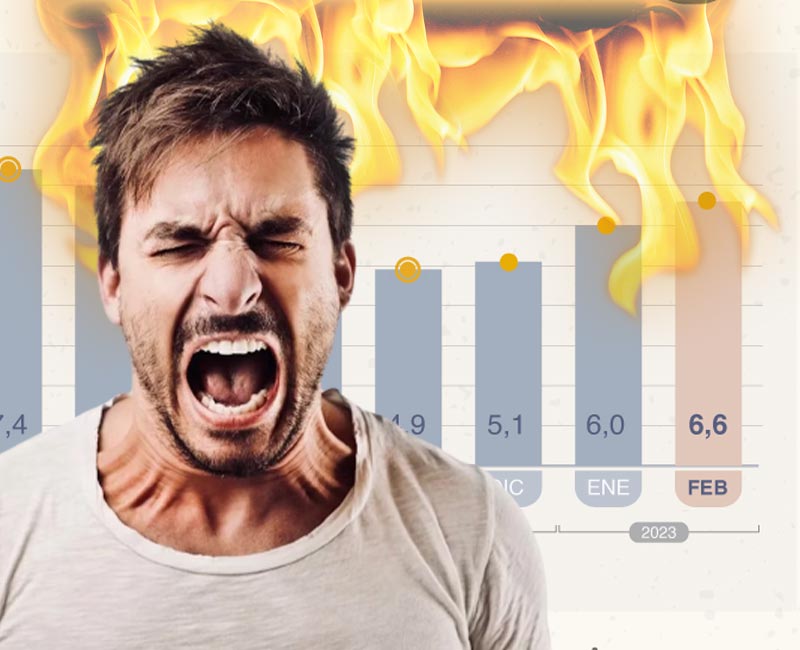
Lo informó el Instituto Nacional de Estadística y Censos (INDEC). Alimentos fue el rubro que más subió.
La inflación de febrero de 2023, la segunda medición del año, fue del 6,6 %, según el índice de Precios al Consumidor (IPC) que informó este martes el Instituto Nacional de Estadística y Censos (INDEC). De esta manera, la interanual llegó al 102,5 %.
Se cortó así con 32 años de niveles inflacionarios menores a los tres dígitos. La última vez que se había llegado a esos niveles fue en 1991.
La categoría que más aumentó fue la de alimentos y bebidas, la cual acumuló un notable incremento de 9,8 % en el último mes.
A este lo sigue el rubro de comunicación, el cual aumentó un 7,8 %. Siguiendo la línea de lo registrado en los últimos meses, restaurantes y hoteles completaron el podio con una suba de 7,5 % registrado en medio de la temporada de verano y mucho movimiento turístico.
Bienes y servicios, por su parte, aumentaron un 6,5 % mientras que la categoría de recreación y cultura subió un 6,1%. Lo sigue salud con 5,3 % y las bebidas alcohólicas con 5,2 %.
El rubro que menos suba registró en el mes de febrero fue el de educación, que en medio de la vuelta a clases, subió un 3,2 %. Prendas y calzado de vestir subió un 3,9 %
Cómo fue la inflación de enero
En la previa, tras el 6% de inflación de enero, se conocía el dato de que si la inflación de febrero superaba el 5,3%, el índice interanual, es decir el de los últimos doce meses, alcanzaría el 100%, un número al que Economía, con Sergio Massa a la cabeza, quería escaparle.
En 2022, la inflación había sido del 94,8%, la más alta desde 1991, y aunque las expectativas del ministro eran las de mantener un IPC por debajo del 4% para los primeros meses del año, en enero esa ilusión se esfumó. “El número no nos gusta”, dijeron el mes pasado desde la cartera económica.
En tanto, el viceministro de Economía, Gabriel Rubinstein, admitió luego a través de Twitter un cambio de expectativas: ahora esperan que la inflación “se acerque a 3%” para fin de año y no para abril, como había dicho Massa.
“Seguimos trabajando desde la macro y desde la micro, para que la inflación baje significativamente, y esperamos que, hacia fines de año, el IPC se acerque al 3%, con inflación en el año rondando 60%”. Las consultoras relevadas por el Banco Central, en cambio, proyectan una inflación del 97,6% para 2023.
En la previa a esta nueva medición publicada por el INDEC, las consultoras privadas habían adelantado que la inflación de febrero iba a estar también rondando el 6%, tal como sucedió en enero. Ese pronóstico se basaba, según un relevamiento del Centro de Economía Política Argentina (CEPA), en una suba de la carne, que aumentó 29% el mes pasado.
Esas mediciones no oficiales oscilaban para febrero entre el 5,7% y el 6,4% para llegar, de ese modo, a la inflación interanual superior al 100% por primera vez desde 1991.
Hasta el momento, el IPC más alto de toda la gestión de Alberto Fernández fue el indicador del pasado mes de julio cuando llegó a 7,4%, siendo la marca más alta desde abril de 2002, cuando alcanzó el 10,4%.
February inflation was higher than expected: 6.6%.
This was reported by the National Institute of Statistics and Census (INDEC). Food was the item that rose the most.
Inflation in February 2023, the second measurement of the year, was 6.6%, according to the Consumer Price Index (CPI) reported this Tuesday by the National Institute of Statistics and Census (INDEC). Thus, the inter-annual rate reached 102.5 %.
Thus, 32 years of inflationary levels below three digits were cut off. The last time such levels had been reached was in 1991.
The category that increased the most was food and beverages, which accumulated a notable increase of 9.8% in the last month.
This was followed by communication, which increased by 7.8%. Following the trend of the last months, restaurants and hotels completed the podium with an increase of 7.5 % in the middle of the summer season and a lot of tourist movement.
Goods and services, on the other hand, increased by 6.5 % while the recreation and culture category rose by 6.1 %. This was followed by health with 5.3% and alcoholic beverages with 5.2%.
The item that registered the least increase in February was education, which in the midst of the return to school, rose by 3.2%. Clothing and footwear rose 3.9%.
Inflation in January
Previously, after January’s 6% inflation rate, it was known that if February’s inflation exceeded 5.3%, the interannual index, that is to say, that of the last twelve months, would reach 100%, a number that Economía, with Sergio Massa at its head, wanted to avoid.
In 2022, inflation had been 94.8%, the highest since 1991, and although the minister’s expectations were to keep CPI below 4% for the first months of the year, in January that illusion vanished. “We don’t like the number,” the economic portfolio said last month.
Meanwhile, the Deputy Minister of Economy, Gabriel Rubinstein, later admitted through Twitter a change of expectations: now they expect inflation “to be close to 3%” by the end of the year and not for April, as Massa had said.
“We continue working from the macro and from the micro, so that inflation drops significantly, and we expect that, by the end of the year, the CPI will be close to 3%, with inflation in the year hovering around 60%.” The consulting firms surveyed by the Central Bank, on the other hand, project an inflation of 97.6% for 2023.
Prior to this new measurement published by INDEC, private consulting firms had anticipated that February inflation would also be around 6%, as it happened in January. This forecast was based, according to a survey by the Centro de Economía Política Argentina (CEPA), on an increase in meat, which rose 29% last month.
These unofficial measurements ranged for February between 5.7% and 6.4% to reach, thus, a year-on-year inflation above 100% for the first time since 1991.
So far, the highest CPI of Alberto Fernández’s administration was last July’s indicator when it reached 7.4%, being the highest mark since April 2002, when it reached 10.4%.











Noticias relacionadas
La transición energética mundial se aceleró en 2025: en qué lugar está Argentina
Bancarios acuerdan aumento salarial en línea con la inflación y el básico supera $1.850.000
Día del Padre: tras la caída de ventas, desde CAME advierten una “situación preocupante” en el comercio